#Aberdeen Bestiary
Explore tagged Tumblr posts
Text






Beasts from Aberdeen Bestiary illuminated manuscript PNGs.
(source)
#png#pngs#transparent#transparents#moodboard#artboard#imageboard#collage#collages#sticker#stickers#mixed media#aberdeen bestiary
2K notes
·
View notes
Text
For #WorldHoneyBeeDay 🐝 here are two golden illuminations from a pair of famous early 13th c. English bestiaries:
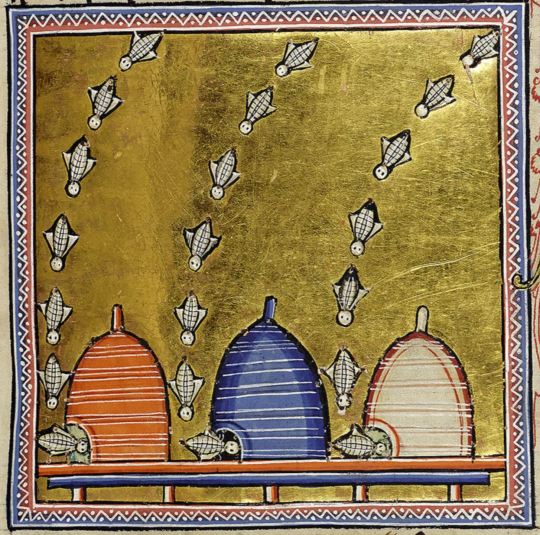
Aberdeen Bestiary, Univ. Lib. MS 24 f.63r Aberdeen University Library
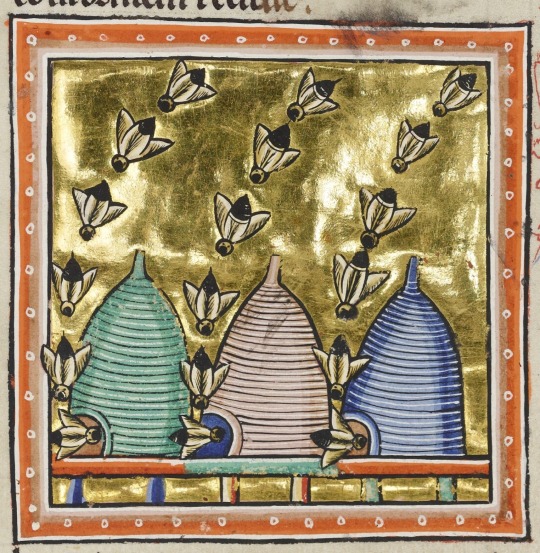
Ashmole Bestiary, MS Ashmole 1511 f.75v Bodleian Libraries
#bee#bees#honeybee#honeybees#honey bee#honey bees#beehive#apiary#medieval art#English art#European art#bestiary#medieval manuscript#illuminated manuscript#illustration#gold leaf#Ashmole Bestiary#Aberdeen Bestiary#Bodleian Libraries#Aberdeen University Library#World Honey Bee Day#animal holiday#animals in art#book art
863 notes
·
View notes
Text

Aberdeen Bestiary
Bat
c. 1200
#aberdeen#bestiary#aberdeen bestiary#bat#c 1200#pint#artists on tumblr#pintura#vintage#stuff#murcielago#darkness#dark#dark wave#dark side#dark aesthetic#grunge#para ti#artes visuales#arte#obra de arte#digital artist#imagenes#imagen#oleo#pinturas#pintar#pintando#vintage style#vintage stuff
22 notes
·
View notes
Text
Thinking about it this way makes me a little less annoyed about it, thank you
The "shrimp colors" meme is part of a long and storied tradition of attributing wonderfully poetic, metaphorically rich, and completely spurious properties to animals and plants. Irises grow from lightning-struck ground, the pelican revives her chicks by drawing blood from her breast with her beak, weasels conceive through the mouth and give birth through the ear canal, the eagle flies up to the sun to burn old age from his eyes, and mantis shrimp see colors we cannot imagine.
It's the kind of thing that fills medieval bestiaries, folk medical traditions, and the writings of Pliny the Elder.
#medieval bestiaries#shrimp colors#the oatmeal#mantis shrimp#iris#pelican#weasel#eagle#aberdeen bestiary#pliny the elder
2K notes
·
View notes
Text
Popular twitter account, Weird Medieval Guys just posted a crazy hyena eating a dude from “The Aberdeen Bestiary” and so I am posting the link in case you want some sick add high medieval illuminated manuscript clout.
#bestiary#high medieval#hyena#Aberdeen bestiary#stolen from twitter#resources#links#MLIS#bibliography
1 note
·
View note
Text

Medieval cats from The Aberdeen Bestiary, circa 1200.
It’s super-fascinating because, while the faces don’t seem particularly feline to me, these are *clearly* drawn from actual observation - look at those classic kitty postures!
You can see more images from the manuscript and read about its provenance here:
#medieval history#cats#kitteh#bestiary#art history#historical animals#the aberdeen bestiary#medieval manuscripts#high medieval
119 notes
·
View notes
Text
Illuminated Manuscripts

“Christ Kneeling in Prayer in the Garden of Gethsemene” (c. 1475 France, Loire Valley)
Illuminated manuscripts embody the extraordinary union of beauty and knowledge.
Though the art of making them disappeared with the advent of the printing press, the most spectacular manuscripts survived the ages.
Here are 8 masterworks of medieval illumination: 🧵
1. The Morgan Crusader Bible, 13th century

Commissioned by French King Louis IX, the Morgan Crusader Bible depicts events from the Hebrew Bible set in the scenery and attire of 13th-century France — it puts a medieval twist on Old Testament stories.
Consisting of 46 folios, the manuscript displays illustrations accompanied by text written in either Latin, Persian, Arabic, or Hebrew.
The vivid colors and attention to detail make it one of the most popular illuminated manuscripts.
2. The Black Hours, 15th century
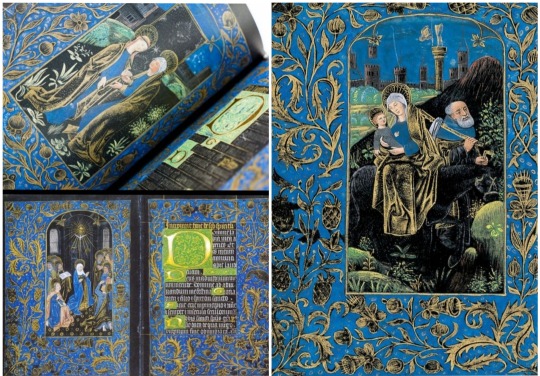
The Black Hours is a book of hours (a type of prayer book) created in Bruges, Belgium.
The style is in imitation of Wilhelm Vrelant, the most popular illuminator of the period and constructed of vellum (calfskin) that’s been dyed pitch black.
Gold and blue paint overlay the dark background to create an almost otherworldly look.
Written in silver and gold ink, the text lists the prayers to be said while depictions of Bible stories aid the reader in meditation.
3. Book of Kells, 9th century

Among the most iconic medieval manuscripts is the Book of Kells.
Created in a Columban monastery, the text is the pinnacle of early medieval calligraphy and illumination.
The graphics are a blend of insular art (the post-Roman era style of art popular in Irish monasteries) and traditional Christian iconography.
Plants, animals, Celtic knots, and biblical figures decorate the 680 page volume to tell the story of Jesus’ life.
4. Codex Argenteus, 6th century
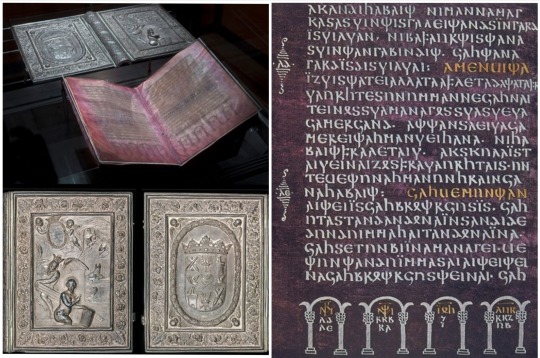
Latin for “Silver Book,” the Codex Argenteus contains the four gospels written in Gothic, making it one of the world’s foremost sources for the now-extinct language.
The book was likely written as a gift for Ostrogothic king, Theodoric the Great.
The work is particularly striking due to its purple-stained vellum pages, metallic ink, and silver binding. Looks almost Tolkienesque…
5. Acre Bible, 13th Century

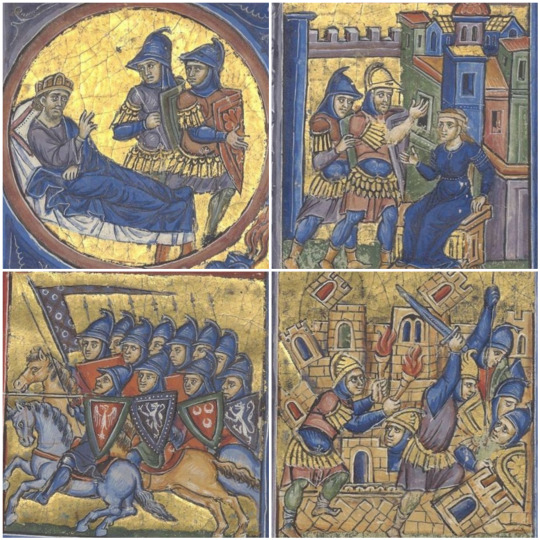
Another work commissioned by Louis IX, the Acre Bible was compiled shortly after the king’s release from captivity during the disastrous 7th crusade.
Upon returning to France, he deposited the masterwork in his newly built Sainte-Chapelle library.
It contains 19 books of the Old Testament, and its illustrations are considered masterpieces of crusader art.
6. The Aberdeen Bestiary, 12-13th century

A bestiary is essentially an encyclopedia of animals and mythical beasts.
They gained popularity throughout the Middle Ages as readers could learn about exotic animals or mythical creatures.
This one was owned by Henry VIII and features a retelling of the Genesis creation story with fantastical images of creatures both real and imagined.
7. The Very Rich Hours of the Duke of Berry, 15th century
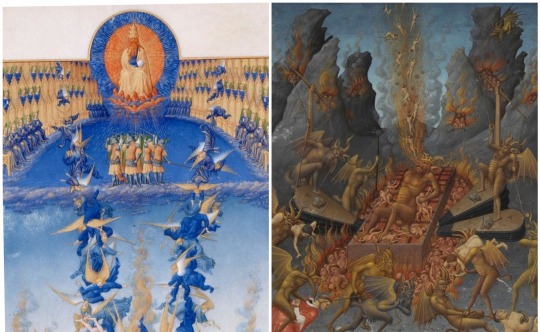
The best surviving example of the International Gothic style of illumination, it’s one of the most lavishly designed late-medieval manuscripts and contains well over 100 illustrations.
Despite beautiful scenes covering most of its pages, the work didn’t shy away from darker imagery.
8. The Berthold Sacramentary, 13th century

Commissioned by the abbot of Weingarten Abbey, this manuscript is a form of missal called a sacramentary used by priests for liturgical services.
A sacramentary gives the priest's readings and prayers for the Mass. This one is a paragon of Romanesque art.
#illuminated manuscripts#medieval manuscripts#medieval illumination#Middle Ages#medieval period#art history#books#handmade books#scribe#illuminator#The Morgan Crusader Bible#The Black Hours#Book of Kells#Codex Argenteus#Acre Bible#The Aberdeen Bestiary#The Very Rich Hours of the Duke of Berry#The Berthold Sacramentary#Wilhelm Vrelant#King Louis IX#medieval calligraphy#Theodoric the Great#bestiary#Henry VIII#Weingarten Abbey#sacramentary#missal
11 notes
·
View notes
Text

I had a careful read of the full text (without spoiling myself of any other entries) from the Aberdeen Bestiary... All I'll say is at least the author calls out 'ill-humoured' husbands too, but phrases like 'You emit a foul venom in the midst of your wifely embrace' are not making me massively positively inclined towards them...
Also, OMG the portholes...! 🤣
Bestiaryposting Results: Rabyeang
This one's posting a few hours later than usual, because due to various circumstances, we ended up recording an episode of the podcast this evening, so I didn't have time to get to it until now.
Anyway, odd and somewhat uncomfortable entry, some parts of it seem clear though. Genuinely interested to see what comes up because I haven't gotten around to checking in on it until right this moment.
Anyone who isn't sure what I'm talking about can find out at https://maniculum.tumblr.com/bestiaryposting.
The entry our artists are working from can be found here:
If you want to join in on drawing the next one, that entry can be found here:
Art is below the cut in the order in which it was posted.

@silverhart-makes-art (link to post here) decided to go with an aquatic creature to make it easier for it to interact with lampreys, specifically a shark because they give live birth. I think the post here is pretty great, and including a lamprey is quite nice actually. Extremely cool-looking all around -- I encourage anyone reading this to check the linked post for a more detailed description of what's going on here and how the artist reached this design.

@cheapsweets (link to post here) has drawn two snakes in the act of twining around each other as the female bites the male's head off. Kind of like a caduceus that's gone wrong somehow. Going in a snake direction makes sense, and the entwined pose I think makes it work. They have also included a rather cute bonus sketch in the linked post along with the explanation of their design, which I encourage y'all to check out. (Also thank you for providing alt text.)
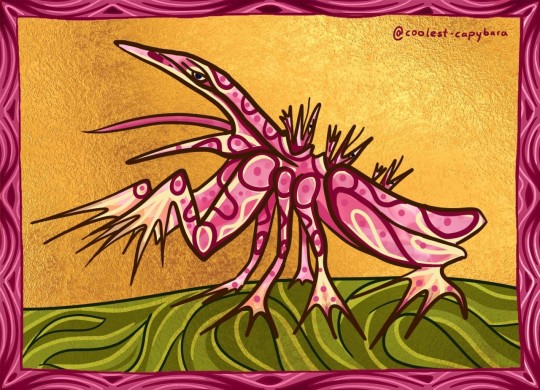
@coolest-capybara (link to post here) has made a very eye-catching but also somewhat... worrying creature by taking inspiration from Surinam toads and orchid mantises. The way those two inspirations are merged is really clever, I think, and as usual I love the medieval-inspired style. This is a creature I appreciate in drawing form but would probably find quite off-putting in real life, which I think is a sign of good design. (Also, thank you for providing alt text.)
That's it this time around, I'm afraid -- this particular entry doesn't seem to have sparked inspiration in many people. (Understandable.) So let's check in with the Aberdeen Bestiary.

So, as I'm sure you've all guessed from the highly accurate illustration, this is the viper.
(I'm getting increasingly curious about what the deal is with this very specific head design you see on so many medieval creatures.)
So yeah, the bit with the lamprey is presumably complicated by the fact that one is an aquatic creature and the other terrestrial -- breath is going to be a concern, at the very least.
I think knowing it's a viper explains a lot of the entry: in the medieval metaphorical space, a viper is of course Very Wicked, so they really run with that here.
I wasn't aware vipers gave live birth, so I Googled it (apparently they do), and interestingly one of the top results was this Quora post:
So apparently elements of this are still hanging around, if someone is asking on the Internet whether vipers really eat their way out of the mother. Also interestingly, the answer makes note of other medieval myths about vipers, including both the head-biting and the lamprey thing. (And also one that female vipers look human above the waist, which is a new one by me.) Instructional.
#rabyeang#maniculum bestiaryposting#bestiaryposting#awesome art#viper#snake#bestiary#aberdeen bestiary#🐍
21 notes
·
View notes
Text

Aberdeen Bestiary
143 notes
·
View notes
Text
Poll 3! Because of the way these sticker sheets are laid out, one design has to be skinnier than the others, so this poll decides which one goes in the Special Skinny Slot.

EDIT: figured out a way to reconfigure the print layout so I can accomodate BOTH the scitalis and the manicule >:)

Okay tumblrinas if I don't get the second series of medieval illuminated manuscript stickers (as seen in this post) printed tomorrow they gotta wait until 2025.
I have four designs ready (above) but I need help with the rest, so we're running some non-binding polls. The first poll is BATS.

#UNFORTUNATELY I love both of these guys#especially after I failed to sketch a good manicule four times and finally nailed it#BUT the Aberdeen Bestiary scitalis is one of my fave medieval illustrations#whichever one doesn't go in series 2 will be in the special skinny slot in series 3
433 notes
·
View notes
Text

















portrayals of bats before 1800:
Bat pendant - jade - China - Shang Dynasty - c.1600-1046 BCE Mastiff Bat Vessel - Moche culture of Peru - 200-850 Codex-style cylinder vase with bat holding plate of body parts - Mayan - c.680-750 The Bat God - terra cotta - Tezoquipan - Aztec - c.700 Bat - Aztec Bat - Aztec Bat - from the Aberdeen Bestiary - England - c. 1200 Bats - from De Natura animalium - Cambrai - c. 1270 Bat - from Pabenham-Clifford Book of Hours - England - c. 1315-1320 Albrecht Durer (German, 1471-1528) - Bat with outstretched wings, and another with wings folded - 15-16th century Albrecht Durer (German, 1471-1528) - stylized bat from Melencolia I - print - 1514 Pieter Boel (Flemish, 1622-1674) - Five Bats - 17th century The Batt - from 'A Description of a Great Variety of Animals and Vegetables' - edited by Thomas Boreman - 1736 bat-shaped vessel - ceramic - China - Qing Dynasty, 1736-95 bats flying over waves - porcelain bowl - China - Yongzheng period (1722-35) Pierre-Paul Barraband (French, 1767-1809) - Bat - 1793 Pierre-Paul Barraband (French, 1767-1809) - Bat - 1794
#art by others#other's artwork#sculpture#painting#ceramic#drawing#print#bats#illumination#Moche#Mayan#Aztec#Albrecht Durer#Pieter Boel#Pierre-Paul Barraband#China
59 notes
·
View notes
Text
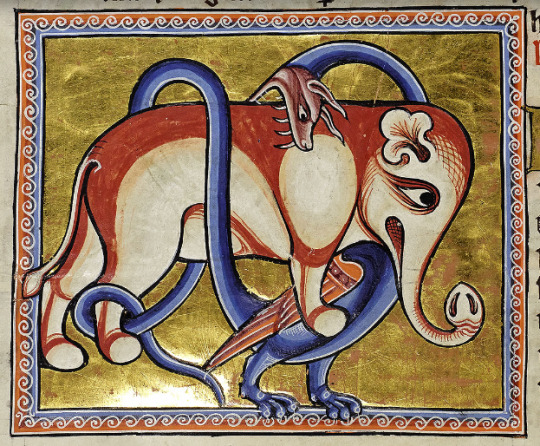
"The dragon has a crest, a small mouth, and narrow blow-holes through which it breathes and puts forth its tongue. Its strength lies not in its teeth but in its tail, and it kills with a blow rather than a bite... From the dragon not even the elephant, with its huge body, is safe. For lurking on paths along which elephants are accustomed to pass, the dragon ties its tail in a knot around their legs and kills them by suffocation. Dragons are born in Ethiopia and India, where it is hot all year round. The Devil is like the dragon; he is the most monstrous serpent of all; he is often aroused from his cave... As he dragon lurks around paths along which elephants pass, so the Devil entangles with the knots of sin the way of those bound for heaven and, like the dragon, kills them by suffocation." From the Aberdeen Bestiary (Translation adapted from the University of Aberdeen's site dedicated to the digitized manuscript.) Materials: parchment, ink, paint, and gold leaf Date: c. 1200 Origin: England (Yorkshire? Lincolnshire? Canterbury?) Now Aberdeen University Library, MS 24, f. 65v
#elephant#dragon#medieval elephants#medieval dragon#bestiary#illuminated manuscript#12th century#13th century
198 notes
·
View notes
Text
Best Gothic manuscript quirk is when the illuminator starts flourishing an initial and then just. Doesn't stop.

Wheeee! Look at them go!
Source: Folio 29v of the Aberdeen Bestiary
111 notes
·
View notes
Text
Bestiaryposting Results: Miscellaneous Sea Creatures
It's the penultimate* Bestiaryposting, and we have sea beasties! Yarrr... okay that's as much as I'm doing of that.
*Strikethroughs explained in the Aberdeen Bestiary section.
Anyone not sure what this is about can consult https://maniculum.tumblr.com/bestiaryposting, which I have fallen terribly behind on updating, but at least after next week I can't possibly fall any more behind.
To read about these Sea Beasties, click here:
For our next and, as I've alluded to repeatedly (assuming I've been counting correctly), last Bestiary Post, click here:
Without further ado, art below the cut.

@silverhart-makes-art (link to post here) has all eight here, and has made the majority of them Not Fish to give us a good oceanic variety. The reasoning behind the Alrittraes (see the linked post) is pretty good, I think, and I'm fascinated by the design of the Radwahrekh.
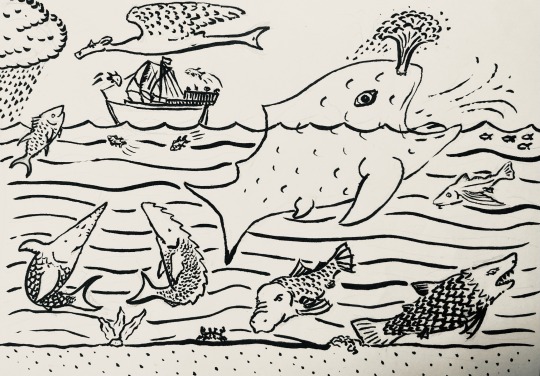
@cheapsweets (link to post here) has given us a similar top-to-bottom oceanic scene in a different style -- these are making me nostalgic for those big illustrations of All The Different Sea Critters I enjoyed staring at as a kid. The Alrittraes is very good in this one too -- I swear I've seen that critter on an old-fashioned Map of the Ocean somewhere. I also like the verging-on-draconic design of the Blochmokan.
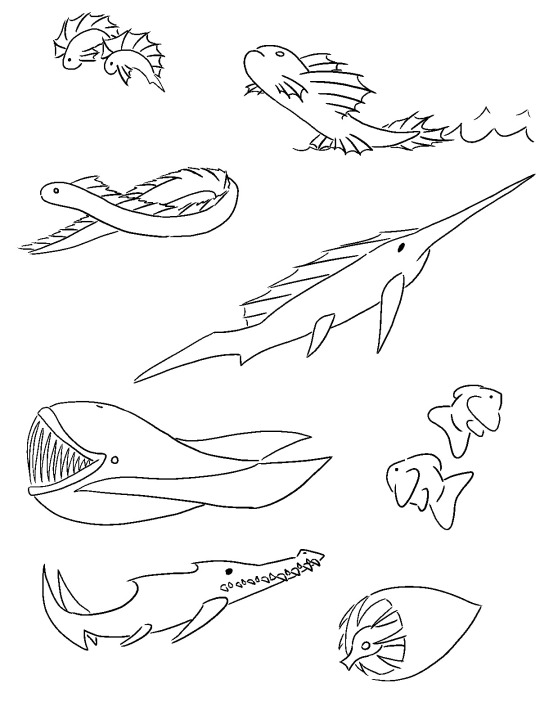
@strixcattus (link to post here) has drawn all eight and attached naturalistic descriptions, as is their wont. Honestly I'm always impressed by how well those descriptions scan as Probably Real Animals. I think the designs of the Alrittraes and Blochmokan are particularly charming here, which is becoming a theme.
So, the Aberdeen Bestiary. No illustrations at all in this section, which is extremely disappointing. Probably due to the author's terrestrial bias. After the above list of creatures, the author goes on an extended digression about fish in general, their feeding and mating habits, and... and apparently Past Me was lazy enough to just skim this whole section on account of each folio just being labeled "Of fish, continued".* Which was a mistake, because it does transition back into talking about specific animals (a number of which are 100% not fish).
*I believe the folio labels are based on the manuscript's rubricated headings, so I can't pass off the blame on them for not making note of this.
So next week isn't the last one, because some of these critters are pretty good, and I can't let Past Me's laziness deny them their time in the spotlight. Once I've typed up this post, I'll go queue up another one to be the actual final Bestiaryposting. A Bestiarypostscript, if you will.
Anyway, the critters from this post.
Alrittraes
I think the water-spout thing flagged to many that this is the whale. Here's the unredacted end of that entry:
Whales are beasts of huge size, so called because of their habit of drawing in and spouting out water; for they make waves higher than other sea creatures; the Greek word balenim [balein] means 'to emit'. The male is called musculus; for it is alleged that the females conceive by intercourse.
In fact, the Ancient Greek phállaina just means 'whale'. (Its original etymology is apparently obscure.) I checked into what balein and balenim might mean just to be sure -- the former is Dutch for 'baleen', which makes sense. The latter is apparently the Czech word for 'package' in either the singular instrumental or plural dative form. So... I don't think this etymology is correct, is what I'm saying.
The bit about conceiving by intercourse, I think, is because they're mammals. Someone either made some observations about genital anatomy or actually observed whale sex out on the high seas somehow, and this was noted as unusual because fish aren't supposed to do that. (The medievals were fully aware of the external fertilization process, they just didn't think it counted.)
I have no idea why this means it is called musculus, and the Oxford Latin Dictionary is not helping.

I was about to continue with this and make some suggestions about the specific design of a mantlet, but honestly I think it's just the author (or, more likely, Isidore of Seville) making up nonsense etymologies.
Update: here I present the entirety of the entry for "mussel", from several pages later, which I think sheds some light on this:
Musculi are small shellfish; oysters conceive from their milk. They are called musculi, meaning, so to speak, masculi, 'males'.
So... maybe. Still weird.
Blochmokan
So this one confused me a bit, because the translator of the Aberdeen Bestiary simply calls it "flying-fish", but that seemed wrong to me because the heading says:
De belua que dicitur serra: Of the monster called the flying-fish.
And I think to myself, (a) why is it a monster? and (b) there's no way serra translates literally to 'flying fish', what is that word?
In an obvious-once-you-see-it moment, serra means 'saw' (whence English serrated). The definition 'sawfish' is also presented, but this is clearly not the same animal we call "sawfish" in English. Nor is it, I strongly suspect, the same one we call "flying fish". (Not least because bestiaries often have a very hierarchical order to them, and why would the flying fish be number two right after the whale?)
Hoping there is an explanation available on the great wide Internet, I Google "serra" "flying fish", and... who should I see as the number one result but the inestimable @a-book-of-creatures. They explain it better than I can.
Kearmoltir
So this is the dolphin, which is quite odd because apparently it means the "certain kind of fish" described here is not actually this guy like we assumed but instead a species of dolphin. Which is wild.
Meldilragg
The translator just renders this as "sea-pig", which I'm not really sure about, because as far as I know sea-pig or mereswine is an old word for 'porpoise'. Maybe they didn't translate it that way because they know something I don't.
Olnranming
This is of course the swordfish.
Radwahrekh
This might be the sawfish, but it does say serra again, so... who knows.
Shikwaewik
This one is the pike, which tracks; I don't think that needs to be elaborated upon.
Gurnwatlea
This one is the mullet, which I was surprised to see. I'm not sure why, maybe it's just because it seems like such a mundane and commonplace fish. But of course we also had some pretty mundane and commonplace mammals in that miscellany, so it's not really that weird.
Anyway, that's... a portion of our sea creatures.
#maniculum bestiaryposting#maniculum miscellaneousseacreatures#Alrittraes#Blochmokan#Kearmoltir#Meldilragg#Olnranming#Radwahrekh#Shikwaewik#Gurnwatlea
65 notes
·
View notes
Text
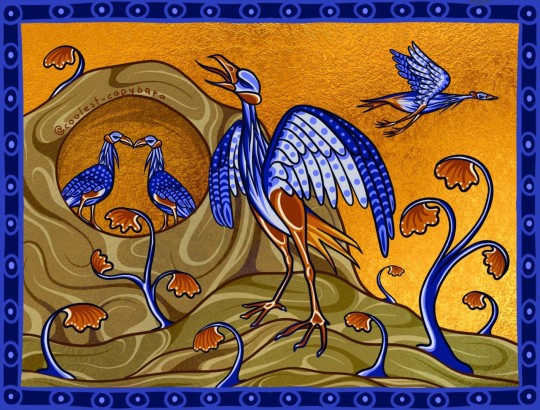
"It is my intention to paint a picture of the Hratgrog, whose wings are sheathed in silver and whose tail has the pale colour of gold."
I think this is the nicest opening to a Maniculum Bestiaryposting Challenge entry we've had so far. If the Hratgrog is what I think it is, the description is much more poetic and friendly than anything you'd hear about this specific bird nowadays, which is a shame.
We get a lot of colours: Silver or sapphire wings "marked by traces of shining white", a golden tail, red feet, saffron-coloured eyes and a body "the colour of a wild sea". The "mixture of snow-white and sapphire", as it is described, made me think of the vulturine guineafowl, so this is what I very loosely based my drawing on. It's a very stylish bird! Also, the bestiary entry specifically states that the Hratgrog "does not feed on corpses", and why would you need to point that out unless the bird looks very much like it would feed on corpses, but doesn't actually do so? Additionally, guineafowl are social birds, and the Hratgrog "flies in groups".
The last bit of the entry is a list of attributes, and I've tried to fit as many of them into the drawing as possible. On the left side, we see that the Hratgrog "likes to kiss" and "nests in holes in rocks", in the middle, that "instead of song it brings forth a lament", and on the right, we see one flying off to fetch some "better-quality grain", carrying a coin in its beak, because the Hratgrog "does not live by theft".
The stylized plants are inspired by some of the examples from the Aberdeen Bestiary we've seen on previous entries, like the Fekthrud.
21 notes
·
View notes



